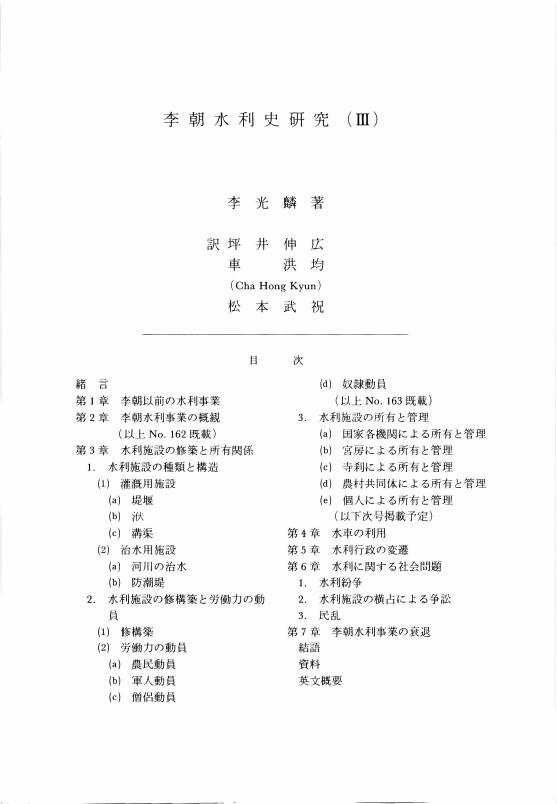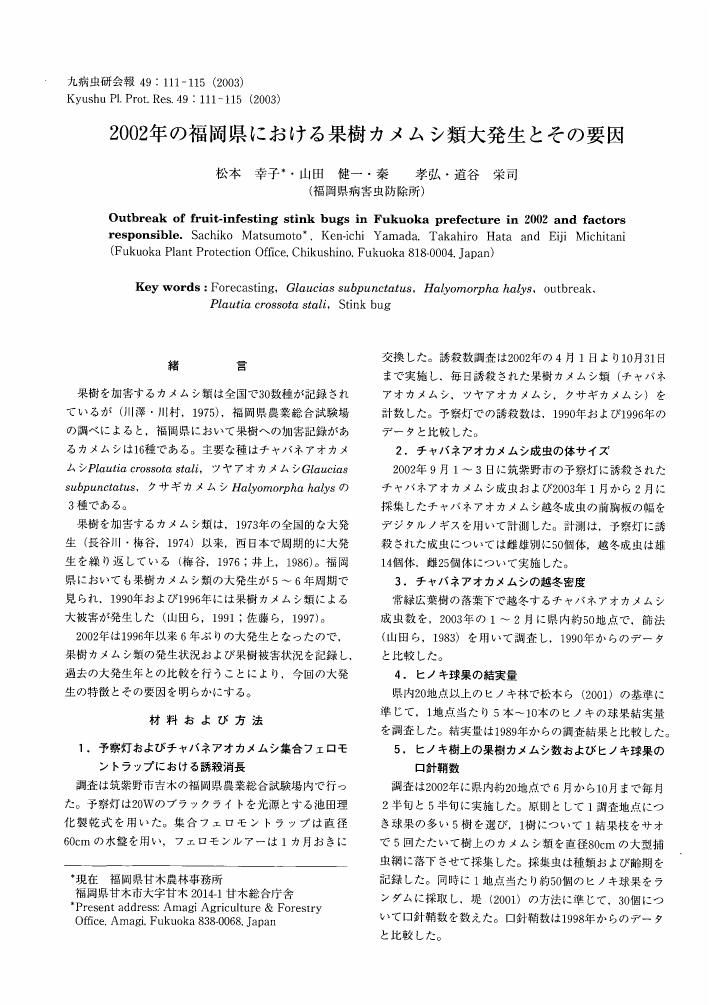1 0 0 0 OA 戦後日本における保育者のライフヒストリーに関する研究
1 0 0 0 OA A-21 上下温度分布を考慮した熱負荷計算 : その2)住宅の実測値を用いた検証
- 著者
- 石田 建一 宇田川 光弘 松本 雄
- 出版者
- 公益社団法人 空気調和・衛生工学会
- 雑誌
- 空気調和・衛生工学会大会 学術講演論文集 平成4年 (ISSN:18803806)
- 巻号頁・発行日
- pp.81-84, 1992-10-07 (Released:2017-08-31)
1 0 0 0 OA 実雷撃による奥獅子吼試験送電線雷サージ特性観測結果
- 著者
- 若井 武夫 松本 安弘 佐久間 治 新庄 一雄 本山 英器
- 出版者
- The Institute of Electrical Engineers of Japan
- 雑誌
- 電気学会論文誌B(電力・エネルギー部門誌) (ISSN:03854213)
- 巻号頁・発行日
- vol.114, no.5, pp.545-546, 1994-05-20 (Released:2008-12-19)
- 参考文献数
- 2
1 0 0 0 OA 自然雷による奥獅子吼試験送電線逆フラッシオーバの観測
- 著者
- 松本 安弘 佐久間 治 新庄 一雄 谷口 弘光 杉本 仁志 酒井 勉
- 出版者
- The Institute of Electrical Engineers of Japan
- 雑誌
- 電気学会論文誌B(電力・エネルギー部門誌) (ISSN:03854213)
- 巻号頁・発行日
- vol.116, no.1, pp.122-123, 1995-12-20 (Released:2008-12-19)
- 参考文献数
- 1
- 被引用文献数
- 1
1 0 0 0 OA 光合成細菌の分布とその存在意義 : 光合成細菌に関する研究 (第21報)
- 著者
- 小林 達治 松本 英明 奥田 東
- 出版者
- 一般社団法人 日本土壌肥料学会
- 雑誌
- 日本土壌肥料学雑誌 (ISSN:00290610)
- 巻号頁・発行日
- vol.37, no.9, pp.447-450, 1966-09-05 (Released:2017-06-28)
1 0 0 0 OA 両眼加重の働きと影響因子 -なぜヒトは2つの眼があるのか-
- 著者
- 若山 曉美 松本 長太 大牟禮 和代 松本 富美子 阿部 考助 田中 寛子 大鳥 利文 下村 嘉一
- 出版者
- 公益社団法人 日本視能訓練士協会
- 雑誌
- 日本視能訓練士協会誌 (ISSN:03875172)
- 巻号頁・発行日
- vol.40, pp.7-18, 2011 (Released:2012-02-22)
- 参考文献数
- 14
- 被引用文献数
- 1 1
両眼から得られた外界の視覚情報は、視覚野で統合され両眼の相互作用によって処理される。この働きについて検討することはヒトが両眼視下でどのように外界の視覚情報を処理しているかを知ることにつながる。本研究では両眼の相互作用である両眼加重に着目し、過去10年間に検討した正常成人における両眼加重の働き、さらに弱視や視野異常を伴う症例での両眼加重について述べる。 両眼加重の評価は、自動視野計Octopus 201、101、900の3種類の視野計を用い両眼刺激装置や両眼固視監視カメラを組み込むなど独自に開発して行った。また両眼からの視覚情報を収斂したことによる働きであるかは確率加重を超えているか検討した上で評価した。 両眼加重は、視標サイズ、網膜部位、認知課題による影響を受け、視標サイズは小さいほど、網膜部位では中心窩から偏心するほど、さらに認知課題では検出閾値よりも認知閾値で大きくなった。さらに閾上刺激を用いた反応時間についての検討では両眼の反応時間は単眼よりも短く、閾値で検討した両眼加重の結果と同様に視標サイズや網膜部位による影響を受けた。 以上の基礎的研究データから単眼で知覚困難な条件において両眼加重を働かせることによってより有効的に視覚情報を処理していると考える。さらに弱視や視野異常を伴う症例では明らかな両眼加重を認めず、正常成人とは異なる両眼での働きを示した。
- 著者
- 橋本 まき 小谷口 美也子 松本 裕貴 琴浦 聡 湯浅 浩気 青木 基 中根 正人 北村 進一
- 出版者
- 公益社団法人 日本食品科学工学会
- 雑誌
- 日本食品科学工学会誌 (ISSN:1341027X)
- 巻号頁・発行日
- pp.NSKKK-D-23-00058, (Released:2023-09-27)
機能性表示食品の機能性関与成分のルーチン分析で求められるスループット性を考慮して, 構築したNP-HPLC簡易法の定量値の妥当性を検証した. ソフトカプセル2粒当たりのプラズマローゲン量をNP-HPLC簡易法と2D-HPLC法で分析し, 得られた定量値と比較したところ, 有意差はみられず定量値の妥当性が確認できた. NP-HPLC簡易法はソフトカプセルやその他の食品中プラズマローゲン含有量について日々のモニタリングに活用できると考える.
1 0 0 0 OA 喀血にて発見された気管支動脈蔓状血管腫の1例
- 著者
- 飯田 慎一郎 松本 吉矢 大搗 泰一郎 河原 正明
- 出版者
- 特定非営利活動法人 日本呼吸器内視鏡学会
- 雑誌
- 気管支学 (ISSN:02872137)
- 巻号頁・発行日
- vol.38, no.3, pp.179-182, 2016-05-25 (Released:2016-06-07)
- 参考文献数
- 14
背景.気管支蔓状血管腫は,気管支動脈が蔓状に走行し,しばしば肺動脈と異常吻合を来す稀な疾患である.発見動機のほとんどが喀血である.症例.症例は70歳女性,繰り返す喀血と呼吸困難を主訴に来院された.胸部単純CTで右B2気管支からの出血を疑い,造影CTでは,右気管支動脈の拡張,蛇行を認めた.気管支鏡検査では気管下部膜様部から右第2分岐部にかけて拍動のある隆起性病変を認め,異常気管支動脈(後に気管支蔓状血管腫と判明)に由来する所見と思われた.しかし,可視範囲に明らかな出血源がなく,気管支動脈造影を行って,右上葉気管支の蔓状血管腫と診断した.肺動脈との明らかな異常吻合は認めなかったが,気管支蔓状血管腫が喀血の原因と判断し,スポンゼルⓇを用いて気管支動脈塞栓術を行い,治癒を得た.施行後1年経過した時点で喀血の再発を見ていない.結語.気管支動脈塞栓術が有効であった気管支蔓状血管腫を経験した.肺動脈との異常吻合のないタイプであったため,長期にわたり再発なく経過することが期待できると考えるものの,慎重な観察の継続を予定している.
1 0 0 0 OA 李朝水利史研究(Ⅲ)
- 著者
- 李 光麟 坪井 伸広 車 洪均 松本 武祝
- 出版者
- 一般社団法人 日本治山治水協会
- 雑誌
- 水利科学 (ISSN:00394858)
- 巻号頁・発行日
- vol.29, no.3, pp.119-136, 1985-08-01 (Released:2020-01-20)
1 0 0 0 OA ファージを薬として使おう
- 著者
- 松本 靖彦
- 出版者
- 公益社団法人 日本生物工学会
- 雑誌
- 生物工学会誌 (ISSN:09193758)
- 巻号頁・発行日
- vol.99, no.5, pp.254, 2021-05-25 (Released:2021-05-25)
- 参考文献数
- 5
1 0 0 0 OA 2002年の福岡県における果樹カメムシ類大発生とその要因
1 0 0 0 OA 寒冷地において疎植栽培した「あきたこまち」の生育,収量,品質
1 0 0 0 OA 左外傷性横隔膜損傷の検討
- 著者
- 田嶋 哲也 春木 茂男 小貫 琢哉 稲垣 雅春 有田 カイダ 薄井 信介 伊東 浩次 松本 日洋 滝口 典聡
- 出版者
- 一般社団法人 日本消化器外科学会
- 雑誌
- 日本消化器外科学会雑誌 (ISSN:03869768)
- 巻号頁・発行日
- vol.51, no.12, pp.806-814, 2018-12-01 (Released:2018-12-29)
- 参考文献数
- 19
横隔膜損傷の治療においては,胸腹部外傷であることを念頭に置いた治療戦略が必要である.当院で経験した左外傷性横隔膜損傷9例と報告例50例の検討から,特に手術アプローチに関して考察する.手術アプローチは,開腹先行46例(2例に開胸追加),開胸先行11例(6例に開腹追加),開胸開腹同時2例であった.予後は合併損傷に影響され,開腹先行で40例生存,6例死亡,開胸先行で6例生存,5例死亡,開胸開腹同時は2例生存であった.循環動態の安定した左横隔膜損傷では手術アプローチを考慮する余地があるが,腹腔内臓器損傷への迅速な対応が予後に影響する可能性もあるため,開腹先行アプローチが推奨される.体位は胸腹部ともにアプローチ可能な右半側臥位が有用であり,開腹+胸腔鏡観察は合理的なアプローチの一つである.
1 0 0 0 OA 透析中の血圧維持機構に関する臨床的研究 ―体液性因子と心機能の影響―
- 著者
- 今村 陽一 久保 明義 松原 渉 熊谷 晴光 原田 篤実 松本 勲 竹中 正治 白石 恒雄
- 出版者
- 社団法人 日本腎臓学会
- 雑誌
- 日本腎臓学会誌 (ISSN:03852385)
- 巻号頁・発行日
- vol.28, no.4, pp.439-445, 1986 (Released:2010-07-05)
- 参考文献数
- 19
In order to evaluate the role of renin-angiotensin system and sympathetic nerve system to maitain the blood pressure during regular hemodialysis (HD), we examined the level of plasma renin activity (PRA), plasma norepinephrine (PNE) and plasma epinephrine (PE) before and after regular HD in 17 patients. The cardiac performance of them was also examined before and after HD by echocardiographic examination. 10 patients (group 1) exhibited stable blood perssure during HD, while 7 patients (group 2) exhibited a fall (≥10 mmHg) in blood pressure during HD. PNE significantly increased after HD in group 1 (217±119 to 317±141 pg/ml, mean±SD, p<0.01), unchanged in group 2 (443±387 to 538±391 pg/ml). PE did not change after HD in both groups: 25.6±17.7 to 25.6±19.8 pg/ml in group 1, 39.7±33. 5 to 34.9 ±24.1 pg/ml in group 2, PRA significantly increased after HD in both groups : 4.01±2.95 to 7.43±4.95 ngAI/ml/hr in group 1, 5.13±6.76 to 8.33±8.97 ngAI/ml/hr in group 2, p<0, 05, for each. There was not significant difference between both groups in the changes of cardiac performance before and after HD. These data suggest that sympathetic nerve system may play a important role on the maintenance of blood pressure during HD.
1 0 0 0 OA 北海道・ニセコ町におけるまちづくりに関する分析・再評価
- 著者
- 押谷 一 松本 懿 深澤 史樹
- 出版者
- 生活経済学会
- 雑誌
- 生活経済学研究 (ISSN:13417347)
- 巻号頁・発行日
- vol.48, pp.99-114, 2018 (Released:2019-03-31)
- 参考文献数
- 4
北海道のニセコ町は、まちづくりの基本概念として「住むことが誇りに思えるまちづくり」を掲げ、情報公開と住民参加を原則とした「ニセコ町まちづくり基本条例」を制定し、「住民参加」による徹底したまちづくりを進めている。 本研究では、ニセコ町の道の駅「ニセコビュープラザ」を取り上げて、まちづくりの特徴や成功要因について整理した。さらに、地元経済界による中心市街地活性化に成功している富良野市のフラノマルシェの取り組みと対比させることにより、まちづくりの普遍的な課題を整理し、効果的なまちづくりのあり方について再評価を行う。
- 著者
- 松本 麻人
- 出版者
- 日本比較教育学会
- 雑誌
- 比較教育学研究 (ISSN:09166785)
- 巻号頁・発行日
- vol.2020, no.61, pp.183-205, 2020 (Released:2023-07-19)
About 40% of private 4-year universities in South Korea are Christian. Although half are ex-Christian theological seminaries, the transformative development process that was involved in their establishment as universities has not been discussed thus far. This paper focuses on the fact that the seminaries, which were unrecognized in the 1980s, were approved as miscellaneous schools as part of a government-controlled, pre-university promotion process. The purpose of this paper is to clarify the influence that these schools later exerted on Christian universities’ development by examining the offensive and defensive process between national policies on unrecognized seminaries, the various strategies that seminaries used, and the transformation that has taken place with. We will discuss how the seminaries’ transformation into miscellaneous schools has contributed to establishment Christian universities. In this paper, we use Barton R. Clark’s triangle model as a theoretical framework. This model sets the state, society, and university as influential factors in the transformation of higher education organizations. This paper adds religious society as an influential factor in the transformation of seminaries. Relevant literature was reviewed in order to explore the details that pertain to government measures and responses from affected seminaries. We referred to published parliamentary minutes, government documents and statistics, and historical school materials. We obtained public government documents that have not been released to the public by requesting the information from government records archives. Moreover, in order to clarify the seminaries’ correspondence, we referred to literature that was in addition to each university’s school history. The 1970s, increase in the number of Christians coupled with the government’s growing restrictions on higher education meant that minister training was outpaced, resulting in many unrecognized seminaries. The government complained that these seminaries were recruiting students for themselves as “schools” and illegally granting degrees. The government then formulated a plan to control such seminaries. An announcement was made that seminaries that meet certain standards would be promoted to universities or miscellaneous schools, and the rest would be closed. The government has also sought to incorporate high-quality seminaries into their higher education system, increasing their capacities and providing financial support. Many seminaries applied for approval given the importance of their maintenance as minister-training schools. In addition, the recognition of the state as a higher education institution has been important for establishing schools’ social status. Obtaining a status that facilitates senior school entrance is useful for effective functioning as an educator training system since educators would obtain future degrees. It is also evident that the various Christian societies place great importance on the maintenance of their seminaries. However, only a few seminaries have been approved. Christian society revolted over the repeal of many seminaries, but some seminaries supported the government. Therefore, the government succeeded in dividing Christianity society. Seminaries in transition were obliged to comply with laws and regulations relating to facilities and equipment, staffing, teacher qualifications, and curricula. The schools had to include Korean history, national ethics and physical education as required subjects. Despite this, the schools became miscellaneous schools because it was possible to maintain the theology department and the essential function of minister training. (View PDF for the rest of the abstract.)
1 0 0 0 OA 生体分子機能を利用した刺激応答性ゲル
- 著者
- 松本 和也 宮田 隆志
- 出版者
- 公益社団法人 高分子学会
- 雑誌
- 高分子論文集 (ISSN:03862186)
- 巻号頁・発行日
- vol.71, no.4, pp.125-142, 2014-04-25 (Released:2014-04-25)
- 参考文献数
- 91
刺激応答性ゲルは,温度やpHなどの外部環境変化に応答して体積変化を示すことから医療分野や環境分野に利用できるスマートマテリアルとして注目を集めている.最近では,疾病などのシグナルとなる生体分子を認識して体積変化する刺激応答性ゲル(生体分子応答性ゲル)も報告されるようになり,ドラッグデリバリーシステムや診断システムなどを構築するためのスマートバイオマテリアルとしての利用が期待されている.このような生体分子応答性ゲルを創製するためには,標的生体分子に対する分子認識とそれによってネットワーク構造変化する応答機能とを連携させなければならない.そこで,これまでは生体分子認識による高分子網目の親水性・疎水性の変化や荷電状態の変化に基づいて生体分子応答性を示すゲルが報告されてきた.最近では,可逆的に結合解離する分子複合体をゲル内の動的架橋点として導入することにより生体分子応答性ゲルが合成されており,タンパク質や糖類をはじめとしたさまざまな標的生体分子に応答するゲルの設計が試みられている.本報では,抗体の抗原認識能などの生体分子機能を利用することによりデザインされた生体分子応答性ゲルについて,国内外の関連研究とともに筆者らの研究を概説する.
1 0 0 0 OA V.免疫チェックポイント阻害薬による大腸炎
- 著者
- 梁井 俊一 菅井 有 松本 主之
- 出版者
- 日本大腸肛門病学会
- 雑誌
- 日本大腸肛門病学会雑誌 (ISSN:00471801)
- 巻号頁・発行日
- vol.74, no.10, pp.599-605, 2021 (Released:2021-11-29)
- 参考文献数
- 63
免疫チェックポイント阻害薬(immune-checkpoint inhibitors:ICI)が悪性腫瘍の標準治療となるに伴い,免疫関連有害事象(immune-related adverse events:irAE)が注目されている.全身諸臓器の中で,消化管はirAEの好発部位であり,なかでも大腸が最も高率である.ICI関連大腸炎の内視鏡所見は血管透見の消失,顆粒状粘膜,発赤,粘液付着,浮腫性粘膜,びらん,潰瘍などであり,病理学的所見として粘膜固有層の拡張,好中球の上皮内浸潤,陰窩の歪み,陰窩膿瘍および顕著なアポトーシスが認められる.このように,ICI関連大腸炎の診断には内視鏡検査と生検が必須であるが,重症度は患者により大きく異なる.また,副腎皮質ステロイドや生物学的製剤などの免疫制御療法を要する重症例も存在するため,本症を見逃さないことが重要である.
1 0 0 0 社会的場面に関する評価の操作が自己評価に及ぼす影響
- 著者
- .*川口 直也 松本 昇
- 雑誌
- 日本心理学会第87回大会
- 巻号頁・発行日
- 2023-08-03
1 0 0 0 マインドワンダリングに関する暗黙理論尺度日本語版の作成
- 著者
- .*服部 陽介 小林 正法 松本 昇 川口 潤
- 雑誌
- 日本心理学会第87回大会
- 巻号頁・発行日
- 2023-08-03







